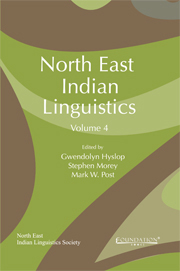Book contents
- Frontmatter
- Contents
- About the Contributors
- Foreword
- A Note from the Editors
- History, Contact and Evolution
- Bodo-Garo Grammar
- Orthography, Poetics and Text
- New Descriptions
- Classifiers
- 12 Classifiers in Mising
- 13 On Classifiers in Asamiya
- 14 Classifiers in Assamese: Their Grammar and Meaning Chains
- Eastern Indo-Aryan Grammar
- Austroasiatic
13 - On Classifiers in Asamiya
from Classifiers
Published online by Cambridge University Press: 05 May 2013
- Frontmatter
- Contents
- About the Contributors
- Foreword
- A Note from the Editors
- History, Contact and Evolution
- Bodo-Garo Grammar
- Orthography, Poetics and Text
- New Descriptions
- Classifiers
- 12 Classifiers in Mising
- 13 On Classifiers in Asamiya
- 14 Classifiers in Assamese: Their Grammar and Meaning Chains
- Eastern Indo-Aryan Grammar
- Austroasiatic
Summary
Introduction
This study is a descriptive account of the classifier system in Asamiya (Assamese), used as one of the most productive noun-encoding devices in the language. Asamiya shares many linguistic features with genetically related Indic languages, particularly with the Magadhan languages of Eastern India, but makes the most extensive and elaborate use of classifiers in terms of their scope and function. This phenomenon is generally ascribed to the influences and counter influences of the non-Aryan languages, particularly the neighbouring Tibeto-Burman languages spoken in and around Assam from the very early periods of its history (Kakati 2007: 278, 381–382; Goswami 1968; Emeneau 1956).
The study is concerned with various aspects of classifiers in Asamiya, as organised into different sections. §2 discusses the distribution of classifiers in the NP structure. §3 deals with the pragmatic, semantic and grammatical functions of classifiers. §4 attempts to subcategorize classifiers on the basis of their semantic considerations, followed by concluding remarks.
The classifiers in the examples are printed in bold and glossed as conglomerations of inherent semantic features without their grammatical or pragmatic information which are interspersed among the relevant texts, tables and/or free translations of examples. However, due to constraints of space, glossing in the Tables has been eschewed.
- Type
- Chapter
- Information
- North East Indian Linguistics , pp. 269 - 291Publisher: Foundation BooksPrint publication year: 2012



